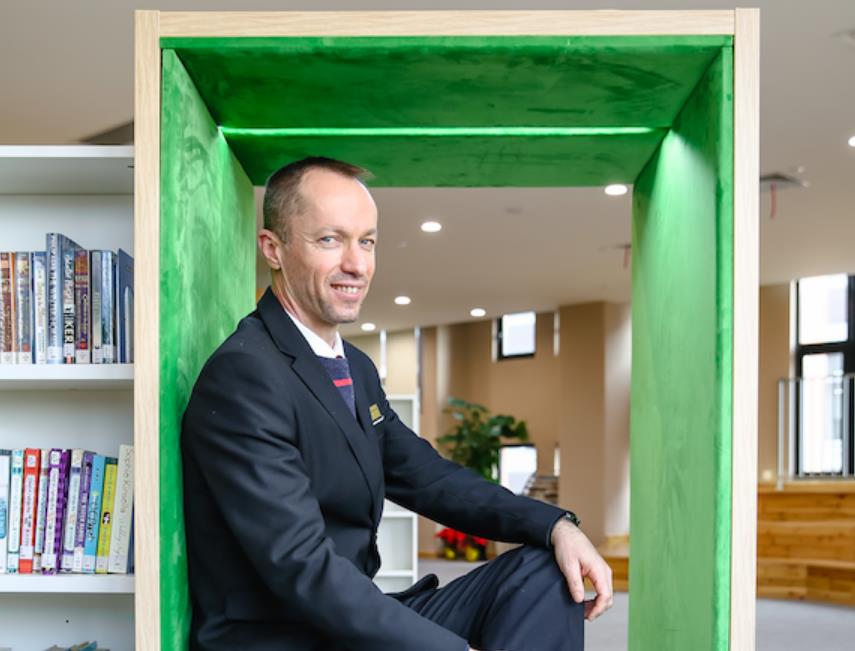We speak to an SSIS ICT teacher to find out more about SSIS’s push to be at the forfront of technology.

When Craig Griebenow, our SSIS Head of Department for Primary School ICT, started teaching, he wanted to develop a broad range of skills and to improve in areas that he was not strong at. So during summer, he continued his lifelong learning journey—away from classes and projects—and used the time to earn an Apple Teacher Certification for iPads. Craig is now a certified Apple Teacher and is working to join the Apple Professional Learner (APL) programme.
The course trains teachers in the main functionality of using their devices (Mac or iPad), explains Craig, who majored in Education and has a diploma in Graphics Design. The Apple Teacher Certification provides teachers with the skills training for using their Apple device. It includes some of the key features offered and, knowing this, allows the teacher to better understand how technology can be used in the classroom. We interview him to find out more about the course and how it can help the SSIS community.
What are your experiences of using technologies in classrooms?
DOS operating system computers were first used in school only when I was in Grade 10. It was before the development of graphic user interface, where people had to type everything onto the telescreen. When I was studying graphic design as a student, I had the opportunity to use the first Apple Macs. After I graduated and became a teacher, I used it in my teaching, but it was not integrated into the curriculum.
What is the best type of technology to use in the classroom?
To make a decision, we have to first think about the skills that we want to teach and what our overall aim is; we have to consider the budget. Thus, it is better to find a versatile tool, which, in my opinion, is the iPad, because the processing chips are potent. Other than being portable, it can also perform all the functions students need.
What are the reasons for joining the APL programme?
Apple has more specialised features as they design both hardware and software to run on the hardware, meaning that the running platform is better. Their devices come with different tools, like GarageBand, iMovie and presentation software, and you get free updates. In terms of Education, students can usually teach themselves elements of the devices, but they will not learn all the functions. So, if the teachers are well-skilled in every aspect, they can assist all the students efficiently and give them the potential for success.
What are the challenges that you faced in this new programme?
Some teachers might not be comfortable with technology in class because some find it quite terrifying. However, our teachers are professionals in education and they are open to learning the functions of devices. The other thing that needs to be completed is a five-year strategy for training teachers and educating parents. I believe that the only way to persuade everyone is to research the schools that have implemented the system. Then, the challenges and issues can be easily identified.There are lots of discussion and reshaping of plans to make sure that everything fits into the overarching aims, goals and vision of the school.
Is there anything interesting that you have learnt in the process?
The certification provides the basics on the functionality of the iPad but also results in interesting pedagogical approaches to teaching. Instead of worksheets and textbooks, students have devices that can access various platforms to build projects that are engaging and exciting. As teachers, we need to be learning new and better ways of teaching, just like our vision to create lifelong learners.
What is the next stage?
A team of teachers have already completed the first stage and earned the Apple Teacher certification. The next step will be to start running a professional development on the ecologies of online learning to inform teachers on the different strategies of how to create contents and projects. Ensuring that all teachers are well-aligned will be challenging, yet it is more efficient in teaching and more engaging and exciting for students.
We are working towards a phase-by-phase adoption of iPads as tools for learning within the Primary School next year. The Senior School is currently using MacBooks as part of their 1-to-1 programme.
What do you hope to achieve?
The world is changing, and the rate of progress is superlative. We have to adjust to prepare students, so they can integrate into this innovative, creative, fast-paced world and be successful once they leave school.
What are your views about the future of Education in SSIS?
I think that the future of Education is exciting because the school structure is showing the openness to grow, learn and change. I see the school adjusting and adopting more technology and developing new pathways for learning, which will better equip the students. For example, adopting AR and VR provides the opportunity for students to be experiencing, learning and developing different skills. In a couple of years, I hope to implement machine learning and other vital technologies that change the way the world is functioning because I am convinced that the students will be able to handle it without any problems.
At SSIS, we aim to provide the most exceptional learning opportunities for our children.










